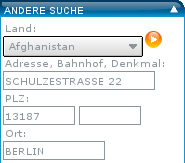September 28th, 2008
September 18th, 2008
time machine
While preparing our relocation which will take place in October I am currently tidying the shelves in my flat from outdated computer magazines. I found some loose pages from the (in the mean time abandoned) magazine “PC-Heimwerker”, issue 3-96. They contain a lot of transcribed paper mailings from users to other users – helping each other…
< < < swooooosh > > >
I am back in the year 2008 – asking my self: “Why did I have kept the pages?” … Probably because of an article about Bresenham’s line algorithm in 16-bit-assembler(!).
Using search engines, news groups, forums or mailling lists on a daily basis – life has become so easy…
August 29th, 2008
Nadelsalut
OpenOffice improves the spelling of the German word “Nudelsalat” (pasta salad) significantly…

August 21st, 2008
GMF toolkits
GMF, the Graphical Modeling Framework supports the creation of graphical editors. For beginners it is very hard to learn. The included wizard has a lot of disadvantages, but it is o.k. for a start. Furthermore the GMF models are very complex and hard to handle. There are different solutions to shorten the time needed for creating a graphical editor:
- EuGENia
- … supports the development of GMF based editors using annotations in your metamodel (
*.ecore) – preferably generated using Emfatic. Dimitrios Kolovos has written a nice tutorial and created a screencast. - ATLflow
- Like in EuGENia – annotations in the metamodel are used to create a graphical editor. It is part of a complete tool chain for model transformations based on ATL. It is used for bootstrapping parts of ATLflow itself.
- GenGMF
- … uses a completely different approach. The GMF models are created from template-like tree structures. A template consist of GMF elements – just ready for duplicating for each metamodel element it is associated with. It is recommended to have some experience with the GMF models, before starting with GenGMF. I developed it to support the creation of editors with a lot of metamodel elements.
Both annotation based solutions are not able to cover all the features possible with GMF, because the GMF models are created using the information stored in the metamodel. The template based approach GenGMF offers a lot more flexibility at the cost of a more complex model.
August 11th, 2008
Diploma Thesis
I am happy to announce that I have finished the writing part of my diploma thesis and that everything has been bundled and filed to the university.
The thesis was written about the creation of a graphical editor for a model driven software development process. The abstract follows below:
„base“ is a model-driven software development environment for internal use by „b+m Informatik GmbH Berlin“. For editing models in „base“ a tree-based editor has been used in the past, which builds on the Eclipse Modelling Framework (EMF). A tree representation in particular is difficult to manage for the dataflow model, because conceptionally the model represents a graph in the mathematical sense of the word. The objective of this thesis was essentially optimizing the developmental process in „base“. To this end, a graphic editor for dataflow models was developed on the basis of the Graphical Modelling Framework (GMF). The meta-model, on which the dataflow models are based, contains 20 element types, which can be placed directly in the editor’s drawing area. The complexity of the models used in GMF increases over proportionally though with the number of element types and is consequently difficult to administrate. This was the reason for developing „GenGMF“ instead of implementing a graphic editor with GMF itself. „GenGMF“ is a Domain Specific Language with an appropriate generic model-to-model transformation for the automatic construction of GMF models. The dataflow editor was modeled using this new development for the construction of graphic editors. Using „GenGMF“ for development of the dataflow editor allowed construction of a „GenGMF“ model requiring 72% less model elements than generated GMF models. In addition, it did not have to be manually adjusted. The result is ease of use for presentation in the graphic dataflow editor.
If you have any questions regarding the thesis, „GenGMF“ or „base“ just send me a note.
July 19th, 2008
Translation
| At least the flowers on the balcony have been copied and pasted with translation. |  |
May 21st, 2008
A picture is worth a thousand words!
The question is not ‘Is a picture worth a thousand words?’, but
‘Does a given picture convey the same thousand words to all viewers?’
by Marian Petre in Why looking isn’t always seeing
April 23rd, 2008
countdown initiated – 127 days left
I’ve got a letter from my university stating the title of my diploma theses “Entwicklung eines graphischen Editors zur Unterstützung eines modellgetriebenen Entwicklungsprozesses” (Development of a graphical editor to support a model driven software development process) and that I should finish my work before the 28th July (which is 127 days ahead).
April 15th, 2008
MDSD talks
There will will be two talks about MDSD at the TFH Berlin on the 18th April. Both talks – one about using MDSD as productivity gain with the dynamic framework Grails and the other about a Lego Mindstorms NXT (which I have already seen during the Eclipse DemoCamp in Hamburg) – are very interesting.
See you there!

